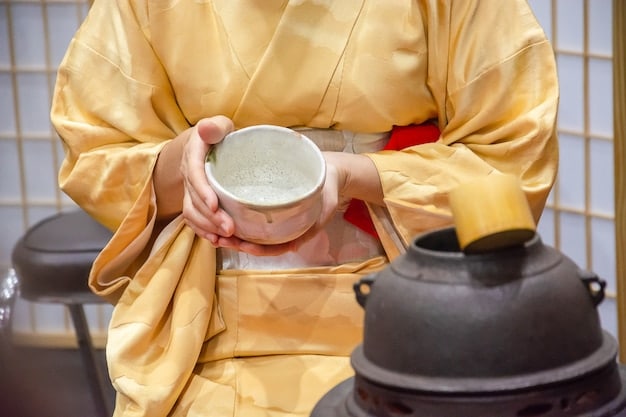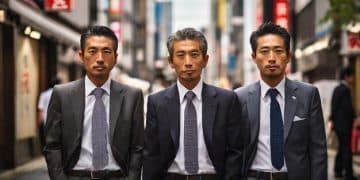Decoding Japanese Society: Understanding Cultural Nuances

Decoding Japanese Society involves understanding the intricate cultural nuances, historical context, and societal values that shape the behavior, communication, and interactions within Japan, crucial for anyone engaging with Japanese culture, whether through J-dramas or real-life experiences.
Ever wondered what truly lies beneath the surface of Japanese dramas and everyday life in Japan? Decoding Japanese Society requires more than just watching J-dramas; it’s about understanding the complex tapestry of cultural nuances that shape this unique society.
The Importance of “Reading the Air” (Kuuki wo Yomu)
One of the most challenging aspects of understanding Japanese communication is “reading the air” or *kuuki wo yomu*. It’s the ability to understand unspoken intentions and feelings by observing subtle cues and context.
This skill isn’t just about being polite; it’s a fundamental aspect of social harmony in Japan. Failing to “read the air” can lead to misunderstandings and social awkwardness.
Understanding Non-Verbal Communication
Non-verbal cues play a significant role in Japanese communication. These include facial expressions, body language, and tone of voice.
- Facial Expressions: A smile might not always indicate happiness; it could also mask embarrassment or discomfort.
- Body Language: Bowing is a common form of greeting and showing respect. The depth and duration of the bow convey different levels of politeness.
- Tone of Voice: A soft, gentle tone is often preferred over a loud or assertive one, especially in formal settings.
Therefore, mastering *kuuki wo yomu* not only enriches your understanding of Japanese dramas, but also significantly improves real-life interactions within Japanese society.
Hierarchy and Respect: Navigating Social Structures
Japanese society places a strong emphasis on hierarchy and respect, which are deeply rooted in its history and cultural values. Understanding these social structures is critical for anyone wanting to comprehend Japanese interactions.
These concepts influence everything from business interactions to family dynamics. Knowing your place and showing appropriate respect are paramount.

The Role of Seniority (Senpai-Kohai)
The *senpai-kohai* relationship is a fundamental aspect of Japanese hierarchy. *Senpai* are senior members, and *kohai* are junior members.
This system is prevalent in schools, workplaces, and even hobby groups. *Kohai* are expected to respect and learn from their *senpai*, while *senpai* are expected to guide and mentor their *kohai*.
Using Polite Language (Keigo)
*Keigo*, or polite language, is an essential tool for showing respect in Japanese. It involves using honorific prefixes, humble forms, and respectful verb conjugations.
Different levels of *keigo* are used depending on the social context and the relationship between the speakers. Mastering *keigo* can be challenging, but it’s crucial for making a good impression and avoiding offense.
To summarize, grasping the nuances of hierarchy and respect allows for better understanding of Japanese social dynamics, which deepens your appreciation for the culture depicted in J-dramas and everyday interactions.
Collectivism vs. Individualism: The Group Mentality
Japanese society is often described as collectivist, meaning that the group’s needs and harmony are prioritized over individual desires.
This collectivist mindset influences various aspects of Japanese life, promoting teamwork, cooperation, and a sense of belonging.
- Teamwork: Collaboration is highly valued in Japanese workplaces. Employees often work together towards common goals.
- Harmony: Maintaining harmonious relationships is crucial. Direct confrontation is typically avoided in favor of indirect communication and compromise.
- Social Expectations: Individuals are expected to conform to social norms and fulfill their roles within the group, whether it’s the family, company, or community.
The contrast between collectivism and individualism sheds light on apparent conformity in Japanese settings. This offers greater insight while watching J-dramas and studying Japanese culture.
The Concept of “Face” (Mentsu): Preserving Dignity
The concept of “face,” or *mentsu*, is deeply ingrained in Japanese culture. It refers to one’s reputation, honor, and social standing.
Preserving “face” is essential for maintaining social harmony and avoiding embarrassment. Actions that could cause someone to lose “face” are carefully avoided.
Avoiding Direct Criticism
Direct criticism or public reprimands can cause someone to lose “face”. Therefore, feedback is often delivered indirectly and diplomatically.
Subtle hints, suggestions, and non-verbal cues are used to convey concerns without directly confronting the individual.

Maintaining Harmony (Wa)
Maintaining *wa*, or harmony, is closely linked to preserving “face”. Disrupting social harmony can cause discomfort and embarrassment for everyone involved.
Japanese people often go to great lengths to avoid conflict and maintain a peaceful atmosphere, even if it means sacrificing personal preferences or desires.
Understanding the significance of ‘face’ deepens appreciation of interpersonal relationships shown in J-dramas, along with various daily communication strategies utilized across Japanese society.
Tradition vs. Modernity: Balancing the Old and New
Japan is a country that beautifully balances tradition and modernity. While embracing technological advancements and modern lifestyles, it also cherishes its rich cultural heritage.
This blend of old and new can be seen in various aspects of Japanese society, from architecture and fashion to social customs and entertainment.
- Traditional Arts: Calligraphy, tea ceremony, and traditional music continue to thrive alongside modern art forms and entertainment.
- Technological Innovation: Japan is a global leader in technology, constantly pushing the boundaries of innovation in fields like robotics, electronics, and transportation.
- Respect for Heritage: Ancient temples, shrines, and historical sites are carefully preserved and remain important centers of cultural and spiritual life.
The interplay between tradition and modernity creates a vibrant and dynamic cultural landscape. Understanding the role of each ensures a deeper understanding of modern Japanese society.
Festivals and Celebrations: Experiencing Cultural Identity
Japanese festivals, also known as *matsuri*, are vibrant celebrations of cultural identity and community spirit. These festivals offer a glimpse into Japan’s rich history and traditions.
*Matsuri* often involve colorful parades, traditional music and dance, and delicious street food. They provide a unique opportunity to experience Japanese culture firsthand.
Seasonal Festivals
Many *matsuri* are linked to seasonal events, such as cherry blossom viewing in spring, summer firework displays, and autumn harvest festivals.
Each season brings its own unique festivals and celebrations, reflecting the close connection between Japanese culture and the natural world.
Local and Regional Festivals
In addition to nationwide festivals, many local and regional *matsuri* celebrate unique aspects of their area’s history, traditions, and local products.
These local festivals offer a more intimate and authentic cultural experience, showcasing the diversity and richness of Japanese culture.
Engaging with these festivals expands horizons and leads to a deeper connection with Japanese culture as encountered whether in J-dramas or in other media.
The Importance of Onsen (Hot Springs) Culture
Visiting an *onsen*, or hot spring, is an integral part of Japanese culture and a popular pastime for both locals and tourists. *Onsen* are believed to have therapeutic properties.
The ritual of bathing in *onsen* is deeply rooted in Japanese history and tradition, providing a unique social and relaxation experience.
- Etiquette: There are specific rules and etiquette to follow when using an *onsen*, such as washing thoroughly before entering the bath and avoiding loud conversations.
- Health Benefits: The mineral-rich waters of *onsen* are believed to have various health benefits, from relieving muscle pain to improving skin conditions.
- Social Experience: *Onsen* are often a place for socializing and relaxing with friends and family. They offer a chance to disconnect from the stresses of everyday life.
Therefore, experiencing *Onsen* culture provides more than just physical relaxation, it leads to greater awareness of social customs crucial insight into Japanese daily life and culture.
| Key Aspect | Brief Description |
|---|---|
| 🤔 Kuuki wo Yomu | “Reading the air” involves perceiving unspoken feelings and intentions. |
| 🤝 Hierarchy & Respect | Social structures emphasizing seniority and polite language (Keigo). |
| 🎎 Collectivism | Prioritizing group needs and harmony over individual desires. |
| ♨️ Onsen Culture | Hot springs are a key part of Japanese culture, with specific etiquette and health benefits. |
Frequently Asked Questions
▼
“Kuuki wo yomu” means “reading the air.” It refers to the ability to understand unspoken intentions and feelings from subtle cues, and context. It’s vital for social harmony and avoiding misunderstandings in Japan.
▼
The senpai-kohai system establishes a hierarchy where senpai (seniors) mentor kohai (juniors). Kohai respect and learn from senpai, who in turn guide and offer advice, particularly in schools and workplaces.
▼
Preserving “face” (*mentsu*) is critical as it relates to one’s reputation, honor, and social standing. Protecting another’s “face” maintains harmony and avoids embarrassment, influencing communication and behavior.
▼
Tradition persists alongside modernity in Japan through preserving cultural heritage, such as tea ceremonies and temples, while also embracing technological innovation, resulting in a unique blend of old meeting new.
▼
Onsen are pivotal for relaxation and therapeutic benefits, with rich mineral waters. Etiquette surrounds onsen use, as they’re often used for socializing, reinforcing their relevance in Japanese social customs.
Conclusion
Decoding Japanese society involves understanding numerous interconnected elements: non-verbal cues, emphasis on group harmony, intricate social hierarchies, the need to maintain “face”, and the unique blend of tradition and modernity. Developing greater insight into these key aspects provides a more profound understanding of the social dynamics depicted in J-dramas and experienced in Japanese society, leading to richer cultural engagement and deeper appreciation.





